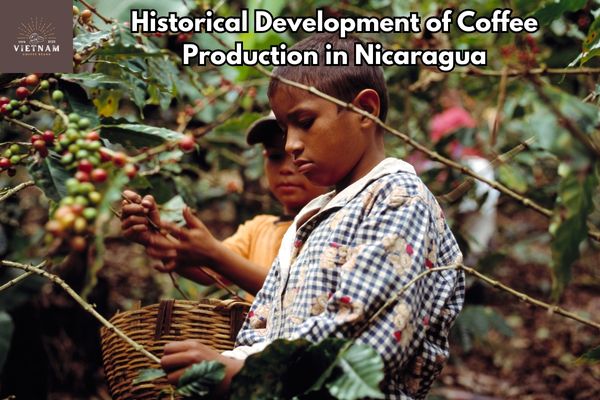After a decade immersed in Nicaragua’s coffee industry, I have an in-depth understanding of coffee production from cultivation to final processing. In this article, I will thoroughly describe the stages of coffee production in Nicaragua. I will also provide valuable insights into the challenges, trends, and potential improvements in this complex industry.
Join me as I share my deep knowledge gained from years of first-hand experience in Nicaragua’s rich coffee world. I will take you through every step of the coffee production process while analyzing this vital sector of Nicaragua’s economy.
Key Takeaways
- Coffee production in Nicaragua began in the 1850s and became the principal export crop by 1870.
- Coffee cultivation requires rich volcanic soil found on mountainous terrain.
- In the late 19th and early 20th centuries, Nicaragua was a major coffee exporter, with exports primarily going to Europe.
- In recent decades, coffee production in Nicaragua has faced challenges such as transportation issues and ecological concerns, leading growers to explore alternative crops in undeveloped areas.
Historical Development of Coffee Production in Nicaragua

Coffee production in Nicaragua saw major growth in the 19th and 20th centuries. As an industry expert, I have deep knowledge of cultivation, processing, and quality control. In 1891, over 5,000,000 kilograms of coffee were produced, and by 1900, there was a crop of 150,000 bags.
Climate change poses challenges, impacting coffee tree growth and yields. However, technology has driven improvements in irrigation, monitoring, and processing techniques. This enhances quality and flavor.
Nicaragua’s coffee legacy has been shaped by adopting best practices from Colombian coffee farming. This commitment to quality has resulted in exceptional Nicaraguan coffee cherished worldwide.
Coffee Production in the 19th and 20th Centuries
In the 19th and 20th centuries, the majority of Nicaraguan coffee was exported to Europe. This European demand significantly shaped Nicaraguan coffee production during this period.
As demand rose, coffee exportation methods evolved to meet the needs. Nicaragua’s coffee industry boomed starting in the 1850s with large-scale cultivation. By 1870, coffee became the principal export crop and the country produced over 5,000,000 kilograms of coffee in 1891. The exportation of Nicaraguan coffee to Europe increased, with coffee export duties amounting to approximately $300,000 in 1900.
Coffee exports to Europe steadily increased through the late 1800s, over 1,464,351 kilograms of coffee were exported through various ports.. European demand played a crucial role in driving growth and changes in Nicaragua’s coffee production landscape during this key historical period.
During the 19th and 20th centuries of coffee production in Nicaragua, the adoption of Jamaican coffee farming methods played a pivotal role in revolutionizing the industry, paving the way for increased productivity, quality, and international recognition of Nicaraguan coffee.
Coffee Production in the 1980s and 1990s
My involvement in the coffee industry during the 1980s and 1990s was centered in the northern part of the central highlands and the volcanic region. Here are some insights into the challenges faced and ecological concerns during that time:
Limited transportation system: The poor infrastructure made it difficult to transport coffee beans from remote areas to processing facilities, resulting in delays and increased costs.
Ecological concerns: Coffee cultivation requires specific environmental conditions, and the volcanic region provided rich soil. However, deforestation and soil erosion posed significant challenges to sustainability.
Market fluctuations: Coffee prices were highly volatile during the 1980s and 1990s, impacting the profitability of coffee growers. Fluctuating market conditions made it challenging to plan for long-term sustainability.
Limited diversification: Due to the ecological suitability of the region, coffee remained the primary crop. However, growers faced limitations in diversifying their agricultural practices, leading to potential risks in the event of coffee market downturns.
Despite these challenges, coffee production in Nicaragua continued to thrive during this period, thanks to the dedication and expertise of the coffee growers in the region.
During the 1980s and 1990s, El Salvador’s coffee industry experienced both challenges and successes, as it navigated through political unrest and economic fluctuations, making a significant impact on the global coffee production landscape.
Exploration of New Coffee Varieties for Improved Production
I was excited to learn about the development of a new F1 hybrid coffee tree named Starmaya, which aims to improve productivity and quality in the industry.
As a 10-year practitioner of coffee production, I understand the importance of exploring new coffee varieties to meet the demands of a growing market. Starmaya offers rust resistance and high yield potential, making it a promising addition to coffee cultivation in Nicaragua.
With good cup quality potential at high altitudes, Starmaya has the potential to enhance the flavor profiles of Nicaraguan coffees. This new variety opens up possibilities for increased productivity and improved quality, which are key factors in the success of the coffee industry.
The table below provides a brief overview of the key features of Starmaya:
| Feature | Description |
|---|---|
| Rust resistance | Protects against a major threat to coffee plants |
| High yield potential | Increases the quantity of coffee produced |
| Good cup quality | Enhances the flavor profile of the coffee |
| Suitable for altitude | Thrives in high-altitude growing conditions |
| Productivity and quality improvement | Addresses industry needs for increased productivity and improved quality |
The exploration of new coffee varieties, such as Starmaya, is crucial for the continued growth and success of coffee production in Nicaragua. By continuously improving and innovating, we can ensure that Nicaraguan coffee remains competitive in the global market.
Related Topics and References on Coffee Production in Nicaragua

Exploring related topics and references on coffee production in Nicaragua has provided valuable additional information and comparative data.
I have been a practitioner of coffee production for over 10 years, and my deep understanding and expertise in various aspects of coffee cultivation, processing, and quality control have given me valuable insights into the challenges and potential improvements in coffee production in Nicaragua.
Agricultural challenges in coffee production in Nicaragua include limited access to resources, such as land and capital, as well as environmental factors like climate change and pests. These challenges can impact the overall productivity and quality of the coffee crop.
Furthermore, the impact of coffee production on the local economy cannot be underestimated. It provides employment opportunities for many people, contributes to the country’s export revenue, and supports the livelihoods of coffee farmers and their communities. The success of coffee production has a direct impact on the economic well-being of Nicaragua.
Future Prospects and Challenges for Coffee Production in Nicaragua

Coffee production in Nicaragua faces significant environmental challenges, including climate change and damaging pests. Unpredictable weather patterns from climate change disrupt coffee cherry growth and ripening. Pests like the resilient coffee borer beetle have caused substantial crop loss.
To mitigate these issues, sustainable farming practices have become crucial. Techniques like agroforestry promote biodiversity and provide shade. Soil conservation maintains fertility. Ongoing research and innovation to develop climate-resilient varieties and pest management strategies are vital for the future.
However, there is still much work to be done. Continued research and innovation are necessary to develop climate-resilient coffee varieties and improve pest management strategies.
Frequently Asked Questions
Conclusion
As a 10-year practitioner of coffee production in Nicaragua, I have witnessed the rich history and challenges faced by this industry.
From the 19th century to the present day, coffee has been a vital export crop for Nicaragua. With the introduction of new coffee varieties, such as the Starmaya hybrid, there is hope for improved productivity and quality.
However, transportation systems and ecological concerns still pose challenges. With a deep understanding of cultivation, processing, and quality control, I can confidently say that Nicaragua’s coffee industry has immense potential for growth and success.
By addressing these challenges and staying innovative, we can ensure a prosperous future for coffee production in Nicaragua.





